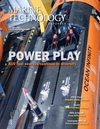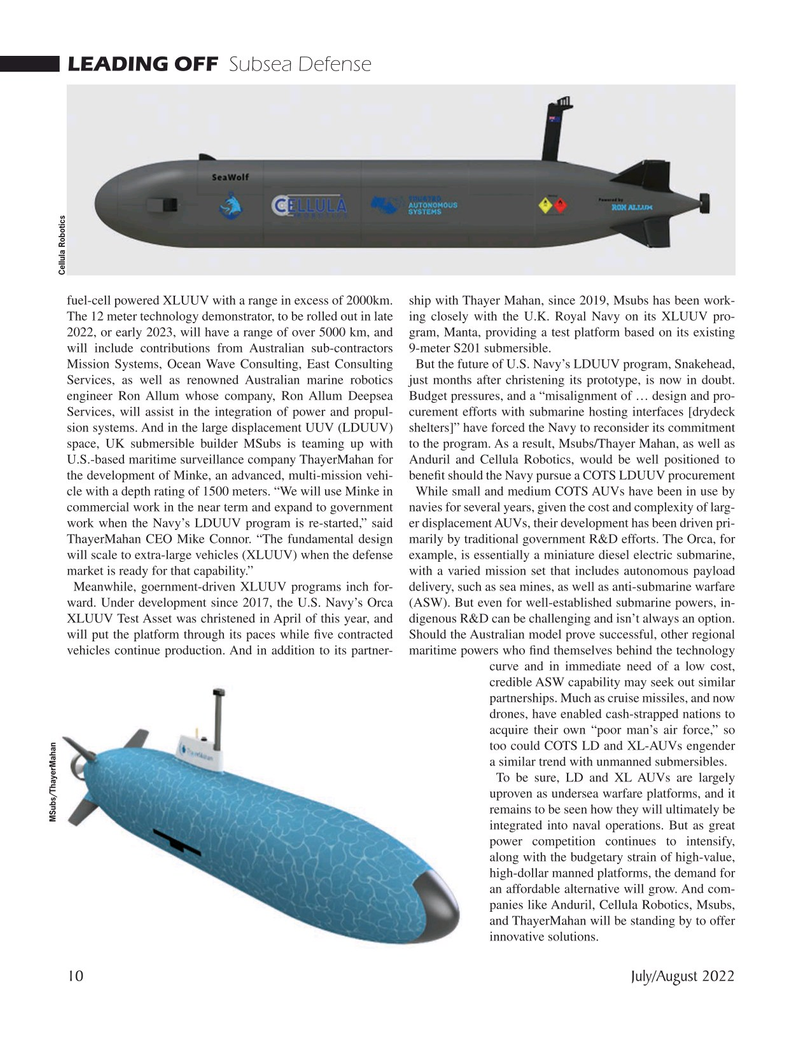
Page 10: of Marine Technology Magazine (July 2022)
Read this page in Pdf, Flash or Html5 edition of July 2022 Marine Technology Magazine
LEADING OFF Subsea Defense
Cellula Robotics fuel-cell powered XLUUV with a range in excess of 2000km. ship with Thayer Mahan, since 2019, Msubs has been work-
The 12 meter technology demonstrator, to be rolled out in late ing closely with the U.K. Royal Navy on its XLUUV pro- 2022, or early 2023, will have a range of over 5000 km, and gram, Manta, providing a test platform based on its existing will include contributions from Australian sub-contractors 9-meter S201 submersible.
Mission Systems, Ocean Wave Consulting, East Consulting But the future of U.S. Navy’s LDUUV program, Snakehead,
Services, as well as renowned Australian marine robotics just months after christening its prototype, is now in doubt. engineer Ron Allum whose company, Ron Allum Deepsea Budget pressures, and a “misalignment of … design and pro-
Services, will assist in the integration of power and propul- curement efforts with submarine hosting interfaces [drydeck sion systems. And in the large displacement UUV (LDUUV) shelters]” have forced the Navy to reconsider its commitment space, UK submersible builder MSubs is teaming up with to the program. As a result, Msubs/Thayer Mahan, as well as
U.S.-based maritime surveillance company ThayerMahan for Anduril and Cellula Robotics, would be well positioned to the development of Minke, an advanced, multi-mission vehi- bene? t should the Navy pursue a COTS LDUUV procurement cle with a depth rating of 1500 meters. “We will use Minke in While small and medium COTS AUVs have been in use by commercial work in the near term and expand to government navies for several years, given the cost and complexity of larg- work when the Navy’s LDUUV program is re-started,” said er displacement AUVs, their development has been driven pri-
ThayerMahan CEO Mike Connor. “The fundamental design marily by traditional government R&D efforts. The Orca, for will scale to extra-large vehicles (XLUUV) when the defense example, is essentially a miniature diesel electric submarine, market is ready for that capability.” with a varied mission set that includes autonomous payload
Meanwhile, goernment-driven XLUUV programs inch for- delivery, such as sea mines, as well as anti-submarine warfare ward. Under development since 2017, the U.S. Navy’s Orca (ASW). But even for well-established submarine powers, in-
XLUUV Test Asset was christened in April of this year, and digenous R&D can be challenging and isn’t always an option. will put the platform through its paces while ? ve contracted Should the Australian model prove successful, other regional vehicles continue production. And in addition to its partner- maritime powers who ? nd themselves behind the technology curve and in immediate need of a low cost, credible ASW capability may seek out similar partnerships. Much as cruise missiles, and now drones, have enabled cash-strapped nations to acquire their own “poor man’s air force,” so too could COTS LD and XL-AUVs engender a similar trend with unmanned submersibles.
To be sure, LD and XL AUVs are largely uproven as undersea warfare platforms, and it remains to be seen how they will ultimately be
MSubs/ThayerMahan integrated into naval operations. But as great power competition continues to intensify, along with the budgetary strain of high-value, high-dollar manned platforms, the demand for an affordable alternative will grow. And com- panies like Anduril, Cellula Robotics, Msubs, and ThayerMahan will be standing by to offer innovative solutions.
10 July/August 2022
MTR #5 (1-17).indd 10 6/30/2022 12:34:20 PM

 9
9

 11
11
